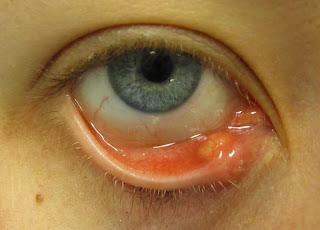What
is a stye?
A stye is a tender,
painful red bump located at the base of an eyelash or under or inside the
eyelid. A stye results from a localized infection of the glands or a hair
follicle of the eyelid. Scientifically a stye is called Hordeolum. It can be of
two types: external hordeolum refers to a stye that develops at the base of an
eyelash, whereas internal hordeolum refers to a stye that develops in a
meibomian gland, a gland located on the underside of the eyelid that secretes
an oily substance onto the eyeball.
When the infection of a
stye persists over time, it can result in scarring around the meibomian gland causing
an usually painless hard swelling in the eyelid called Chalazion.
What
is the cause of a stye?
A stye results from an
infection of the oil glands of the eyelid that help to lubricate the eyeball.
The infection occurs after these glands have become clogged. A stye also may
arise from an infected hair follicle at the base of an eyelash. The bacterium
Staphylococcus aureus that is frequently found on the skin is responsible for
90%-95% of cases of styes.
What
are stye symptoms and signs?
The first signs and symptoms
of a stye are usually redness, tenderness, and pain in the affected area. The
eye may feel irritated or "scratchy." Later signs and symptoms may
include swelling, discomfort during blinking of the eye, watering of the eye,
and sensitivity to light. A common sign of a stye is a small, yellowish spot at
the center of the bump that represents pus rising to the surface.
How
is a stye diagnosed?
A stye is diagnosed by
its characteristic appearance and symptoms. No other tests are necessary to
establish the diagnosis of a stye.
Who
is most susceptible to the development of a stye?
Styes are very common.
People of all ages can develop a stye. Men and women are equally affected. People
with certain chronic conditions like diabetes, seborrhea, and chronic
debilitating illnesses are more prone to develop styes than the general
population. In many susceptible people, stress seems to trigger the development
of a stye. Studies have shown that those who have high levels of blood lipids are
more susceptible to blockages in the oil glands, and are, therefore, more
likely to develop a stye.
Persons with refratice
error not using the correct eye glass power can get recurrent stye. Reccurent stye
is also common in uncontrolled diabetics.
What
is the treatment for a stye? Is there a home remedy for a stye?
Most styes will drain
and resolve on their own without the need for medical treatment. Application of
a warm compress to the affected area for 10-15 minutes, four to six times a
day, can be an effective home remedy and speed rupture of the stye. This will
aid in the relief of symptoms. A stye should not be pressed or squeezed since
this can spread or worsen the infection. If a stye persists for several days, a
doctor may incise the swelling under
local anesthesia in his or her office. Babies or children who require surgical
drainage of a stye may need a general anesthetic. Antibiotic ointments are
prescribed to treat a stye. Rarely, systemic (oral) antibiotics are recommended
for persistent or multiple styes. Over-the-counter pain medications may be used
to alleviate pain and tenderness. Contact lenses and eye makeup should never be
worn during treatment for a stye.
A stye is harmless in
the majority of cases. In most cases, a stye ruptures on its own within a few
days to a week, leading to relief from symptoms. Some people will require
medical or surgical treatment of a stye, as with complications described in the
following section. A stye does not cause damage to the eye. Styes often recur,
but complications of styes are rare.
Are
there any potential complications resulting from a stye?
Complications of a stye
are rare. The infection may spread to other eyelash follicles, leading to
multiple styes. A chalazion is the most common complication that develops from
a stye. Chalazia can be large enough to deform the cornea of the eye and interfere
with vision, and they may cause a cosmetic problem. Other potential
complications include spreading of the infection to the eyelids or other tissues
near the eye. Improper drainage of a stye may lead to deformity or disruption
of growth of eyelashes. Progression of a stye to a systemic infection
(spreading throughout the body) is extremely rare, and only a few instances of
such spread have been reported.
Can
a stye be prevented?
While it is impossible
to completely prevent the development of a stye, good hygienic practices,
including proper hand washing, can help prevent all forms of infection,
including a stye. Other measures that can help prevent styes include
- · never sharing cosmetics or cosmetic tools such as lash curlers or eyelash combs with others,
- · keeping cosmetic tools clean,
- · discarding old or contaminated eye makeup,
- · keeping all cosmetics clean,
- · not touching the eye and surrounding areas.


